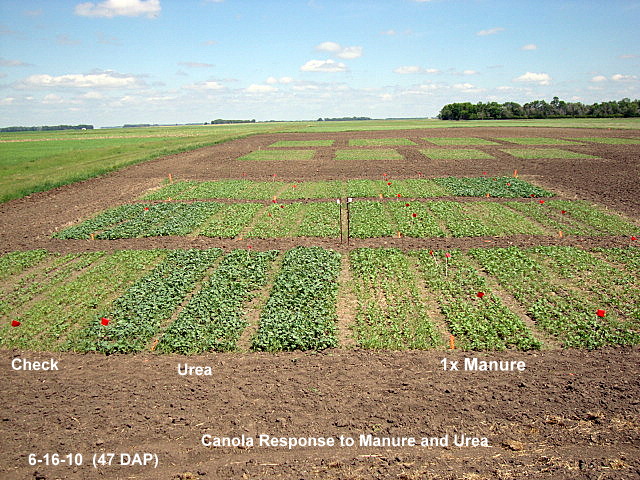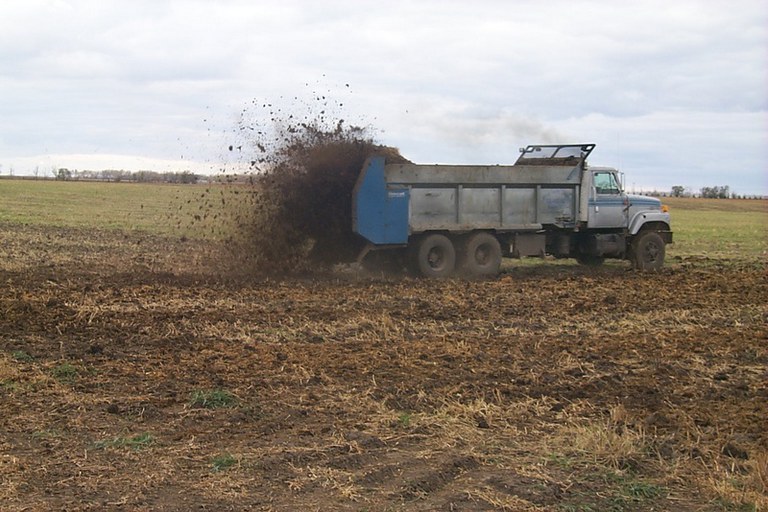North Dakota Manure Fertilizer Use Recommendations (NM1629, Reviewed March 2018)
Availability: Web only
Cover photo by Ron Wiederholt
Animal manure is a great source of nutrients for crop production.
It contains significant amounts of nitrogen (N), phosphorous (P), potassium (K) and lesser amounts of many micronutrients.
However, it must be managed differently than commercial fertilizers. Manure nutrients are primarily in an organic form and need to be made available to plants through microbial breakdown. This natural process is mediated by soil temperature, soil moisture, soil type and other biotic factors. These processes take time, making manure nutrients available more slowly during the growing season.
Because of the natural variability in the amount of nutrients in manure released to crops, many crop producers are hesitant to use manure as a fertilizer source. A research program was initiated at the NDSU Carrington Research Extension Center to address this concern and determine if manure can supply the needed nutrients to grow the crops typically grown in the upper Great Plains.
Research Program Design
Field plot research projects were initiated following standard research protocols that included treatment randomization and replication to account for any field or treatment variations. The crops grown in the trials were corn, canola and hard red spring wheat.
Corn was chosen as a standard comparison crop because a significant amount of field research has been conducted on corn response to manure fertilizers in other parts of the country. Wheat and canola where chosen not only because they are popular in North Dakota but because they have a higher nutrient demand earlier in the growing season than corn.
Five trials were conducted with spring wheat to compare fall- and spring-applied manure with spring-applied commercial fertilizers. Two trials each of canola and corn were conducted to compare spring-applied manure with commercial fertilizer. All of the trials had a check treatment with no fertilizer.
To account for the P in manure, the commercial N fertilizer treatments were supplemented with commercial P equal to the amount in the manure treatments. Some of these trials also had soil investigation components, but this report will focus only on the crop response to the treatments. The trials were conducted during a five-year period (2007-2011), increasing the confidence in the numbers based on weather variation.
What We Learned
A previously published NDSU Extension publication stated that research has shown that 50 percent of the total N in manure is available to the crop in the first year of application. Varying levels of manure N availability were tested in some of the Carrington Research Extension Center trials, and a 50 percent availability rate was shown to be accurate (data not shown).
Table 1 shows the results of the Carrington Research Extension Center corn trials. Corn yields did not vary significantly when manure was used as the sole fertilizer. This was an expected outcome and similar to other research conducted in the Midwest. Table 2 shows the results of the canola trials.
Canola yields were significantly lower when spring-applied manure was the fertilizer source, compared with spring-applied commercial fertilizer. Even though manure supplies the needed sulfur for canola, the release of N is too slow to allow canola to reach its yield potential.
Because crops such as canola and spring wheat have a high N demand early in the growing season, a fall-applied manure treatment was included in the wheat trials. According to the five trials conducted with wheat as shown in Table 3, fall manure-treated plots had statistically similar yields to commercial fertilizer but were, at times, a few bushels lower.

Figure 1. Canola trial showing differences in crop growth based on fertility treatments. All treatments were applied five days before planting.



The yield from spring wheat and canola that received the spring-applied manure always was significantly lower than in crops with the commercial fertilizer or fall-applied manure treatments.
In all the trials, the yield for crops receiving the check treatment with no fertilizer always was significantly lower than in crops receiving the other treatments.
Recommendations for Using Manure as a Fertilizer Source
• Credit 50 percent of total N in the manure analysis as available the first year of application.
• Corn production: Manure nutrients are a complete substitute for commercial fertilizer and can be used as a sole source of nutrients for corn. Manure can be applied in the spring or fall.
• Wheat, canola and other short-season, high N-demand crops: If manure is applied in the spring, 20 to 40 pounds per acre of supplemental commercial N need to be applied at planting to supply early season N. If manure is applied in the fall, enough N should be available by spring, but a 20- to 40-pound-per-acre application of supplemental commercial N at planting may be beneficial.
This publication was authored by: Ron Wiederholt, former Nutrient Management Specialist; Mary Berg, Livestock Environmental Management Specialist; Emily Kline, former Livestock Environmental Management Specialist, Carrington Research Extension Center, 2012
March 2018



